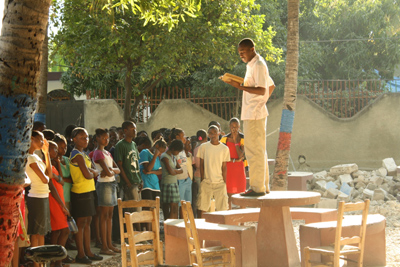
 SENECA—Major clean-up work began recently at the Louverture Cleary School outside Port-au-Prince, Haiti, after a powerful earthquake rocked the country, killing tens of thousands and leaving many more homeless and hungry.
SENECA—Major clean-up work began recently at the Louverture Cleary School outside Port-au-Prince, Haiti, after a powerful earthquake rocked the country, killing tens of thousands and leaving many more homeless and hungry.
The boarding school is operated by The Haitian Project, a Catholic Mission that offers a tuition-free, Catholic secondary education to more than 350 economically under-privileged Haitian children.
Deacon Patrick Moynihan, who is president of The Haitian Project, had just returned to the Upstate Jan. 11, shortly before the earthquake, to spend time with his family near Seneca.
Elizabeth O’Connell, director of community development for The Haitian Project, said the chaotic situation after the quake forced the mission’s officials to immediately fly Deacon Moynihan back to Santo Domingo in the Dominican Republic, which shares the island of Hispaniola with Haiti.
O’Connell said Deacon Moynihan arrived in Santo Domingo the night of Jan. 15, and with the help of the Chinese government was able to charter a flight on a relief aircraft from Santo Domingo west to Port-au-Prince.
“The Chinese government convinced the U.S. military to allow one more flight, Patrick’s flight, to land at the airport,” O’Connell said in an e-mail.
Once back in Haiti, Deacon Moynihan, who serves as deacon at St. Andrew in Clemson, St. Paul the Apostle in Seneca, and St. Francis Mission in Walhalla, was able to get a firsthand look at the quake damage.
In an e-mail, Deacon Moynihan said staff and volunteers removed pieces of the school’s structure because architects and engineers determined they were weakened by the quake and could fall during aftershocks. That work included removal of a railing on the third floor of one of the campus’ older classrooms and dorm buildings.
“We are concerned that the oldest three-story building may need major reinforcement or replacing,” Deacon Moynihan said.
The students at the school were relocated to a nearby soccer field.
“With clearance to go back into the buildings, we will have what we need: housing, food and water,” Deacon Moynihan said.
He praised the school’s staff and volunteers for their work in the immediate aftermath of the disaster.
“Having seen the city and the impact of the quake closer to its center, I am even more amazed at their resilience, drive and focus,” he said.
Deacon Moynihan said the level of devastation in central Port-au-Prince shocked him.
“It was tough to see to be sure. The bodies of the dead are still in inhuman arrangements, places you do not expect to see them. It is shocking and drives one to tears,” he said.
He said it was also difficult to witness the destruction of the National Palace in the heart of the city.
“All of America has lost something. I have made so many visits, proud visits, to this monument of a great people,” Deacon Moynihan said.
And while most of the school seems to have escaped major damage from the quake, the residential neighborhoods that surround it were destroyed.
Deacon Moynihan said he knows of at least two graduates of Louverture Cleary who were victims of the earthquake.
Six current students were also injured, but are expected to recover, Haitian Project officials said.
Two streets down from the school, the wall of a popular market collapsed during the quake and killed an unknown number of people, Haitian Project officials said.
“It has completely fallen — most likely with several friends of our family in it,” Deacon Moynihan said. “The rescue continues, but hope is small.”
Survivors in the neighborhoods of Santo 5 where Louverture Cleary is located have gathered daily at the gates of the school to receive meals prepared by staff and volunteers.
According to Deacon Moynihan, the U.S. military was taking on a widening presence in Port-au-Prince.
“I think we can say that we are near and going over the level of troops we have had [in Haiti] in the past political-issue times,” he said. “This makes one very reassured.”
The Haitian Project has worked with Catholic Relief Services in the ongoing effort to return to normalcy in Port-au-Prince.
“We can do a lot to help with some of their [CRS] issues in warehousing and sourcing of food through our business partners,” Deacon Moynihan said. “We are also on the list to receive food support.”
But that effort will need to go much further in the weeks and months ahead.
“It is clear, given the damage to the business sector, that we will have to rely again more on raising money for food and purchasing,” he said.
To help keep the Louverture Cleary School operating, donations are being accepted online at www.haitianproject.org/donate.htm, or to The Haitian Project, P.O. Box 6891, Providence, RI 02940.
Donate to Catholic Relief Services through their Web site at www.crs.org, which also has instructions for giving via mobile phone service; by calling (800) 736-3467 between the hours of 8 a.m. and 11 p.m. EST; or by mailing donations to CRS, P.O. Box 17090, Baltimore, MD 21203.
